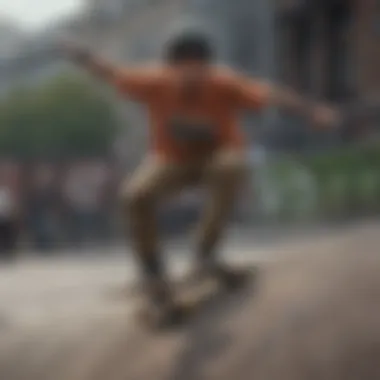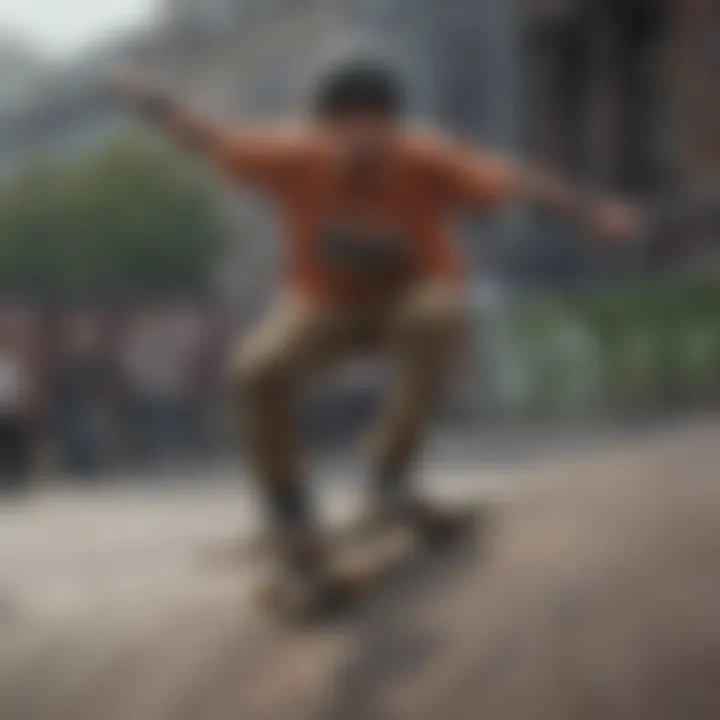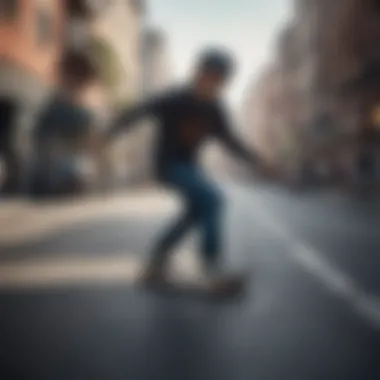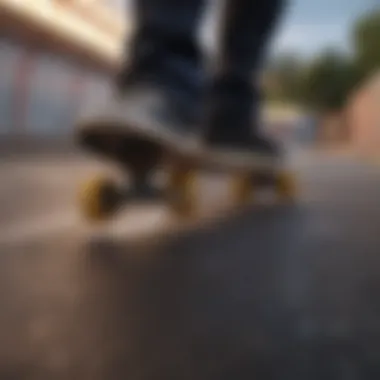The Skate Era: An In-Depth Look at Skateboarding Culture


Intro
Skateboarding has undergone remarkable transformations since its inception in the mid-20th century. Emerging from a simple pastime, it has blossomed into a global phenomenon encompassing unique cultural elements, advanced techniques, and a fervent community. The narrative of skateboarding is not merely about tricks and stunts; it portrays a vivid depiction of an evolving lifestyle. This article will explore the historical context of skateboarding, examine its cultural significance, look at technological advancements, and consider its impact on contemporary extreme sports.
As one delves deeper into the phenomenon of skateboarding, it becomes clear that it is a rich tapestry of passion and creativity. The discussion will address prominent figures who left indelible marks, critical events that shifted its trajectory, and the innovative equipment that revolutionized the sport. By analyzing the skate era through multiple lenses, one can appreciate the depth and breadth of its influence on society at large.
Intro to Skateboarding Culture
Skateboarding culture is a rich and dynamic blend of sport, art, and community. This section sheds light on why understanding this culture is vital. Skateboarding offers freedom and an avenue for self-expression that transcends mere recreation. It creates bonds among skaters through shared experiences in local skate scenes and global connections. This article aims to explore these connections and the cultural footprint of skateboarding.
Defining the Skate Era
The term "Skate Era" refers not only to a period in time but also to a mindset that fuels the passion behind skateboarding. It encapsulates various movements and shifts that have changed the landscape of skateboarding since its inception. The Skate Era signifies a time when skateboarding transitioned from niche activity to a mainstream phenomenon.
Skaters embraced improvisation and innovation. The culture celebrates individuality while promoting collective experiences in parks and streets. Crucially, the Skate Era is characterized by its anti-establishment ethos, appealing to those who challenge the norms of conventional sports.
Historical Context of Skateboarding
Understanding the historical context of skateboarding is essential to fully appreciate its culture. The roots of skateboarding can be traced back to the late 1940s and early 1950s in California. Initially, surfers wanted a way to enjoy the waves on land when the surf was flat. This practice evolved, with wooden planks and roller skate wheels giving birth to the modern skateboard.
By the late 1960s, companies like Hobie and Makaha began mass-producing skateboards. With competitions emerging, skateboarding began to gain traction. The late 1970s and 1980s saw a surge in popularity, characterized by the rise of vertical skating and the first skate parks. Major brands like Powell Peralta and Z-Flex became iconic, bringing skaters together in a way that has shaped the culture until today.
Skateboarding faced hurdles with societal perceptions, often viewed as a delinquent activity. However, as it gained mainstream acceptance, it fostered unique styles and techniques that enriched its practice.
"From the streets to the X Games, skateboarding continues to redefine its boundaries, creating an inclusive culture that welcomes all ages and backgrounds."
This historical context lays the groundwork for deeper exploration into technological advancements and cultural impacts in later sections.
Key Technological Developments
The realm of skateboarding has transformed significantly due to various technological advancements. These developments have affected not only the design and functionality of skateboards but also the broader culture that surrounds skating. Innovations have influenced performance, accessibility, and the overall skateboarding experience. Understanding these technological shifts is crucial to appreciating how skateboarding has evolved and continues to adapt in contemporary society.
Evolution of Skateboard Design
The design of skateboards has undergone substantial change since their inception. Early skateboards were often rudimentary, resembling wooden planks attached to roller skate wheels. Today’s models are a result of refined engineering, incorporating insights from various disciplines.
The shape, size, and materials used have evolved to optimize performance. Modern skateboards typically feature a wider deck, concave shapes, and a variety of lengths. The introduction of materials such as maple wood, fiberglass, and carbon fiber has significantly enhanced durability and performance. Additionally, the wheel composition has shifted to urethane, providing better grip and smoother rides on rough surfaces. These improvements enable skaters to perform tricks with greater ease and safety.
Material Innovations and Performance
Material innovation plays a critical role in the development of skateboarding technologies. Advances in material science have led to boards that are lighter, stronger, and more responsive. For instance, carbon fiber, known for its impressive strength-to-weight ratio, has made its way into advanced skateboard designs. This material provides skaters with greater agility and better control during stunts.
Moreover, the components of skateboards, such as trucks and bearings, have also seen significant improvements. Proprietary formulas for bearings allow for faster spins and increased durability, catering to skaters who push their limits. The enhanced performance delivered by these materials not only affects how tricks are executed but also influences competitive performance in events.
The Role of Skate Parks
Skate parks have become essential environments for the growth of skateboarding culture. They provide dedicated spaces where skaters can hone their skills, socialize, and push each other to new heights. The design of skate parks, often tailored to accommodate various skill levels, features ramps, rails, and pools that mimic real-world conditions. These amenities allow for a controlled environment where skaters can practice safely.
"Skate parks are hubs of creativity and improvement, offering a blend of technical and artistic platforms for skateboarding."


The presence of skate parks has also fostered community and competition, becoming vital for local scenes. Many parks are community-funded, representing grassroots efforts to support skateboarding as a legitimate sport. They have catalyzed the professionalization of skateboarding, providing venues for competitions that redefine the boundaries of the sport.
In summary, technological developments in skateboard design, materials, and the establishment of skate parks highlight the ongoing evolution of skateboarding. Each of these elements has substantially contributed to shaping the sport, offering deeper insights into its cultural and social dimensions.
Cultural Impact of Skateboarding
The cultural impact of skateboarding extends beyond mere recreational activity. It has shaped social dynamics, created communities, and influenced various forms of art and expression. Understanding this impact is essential to appreciate how skateboarding integrates with broader cultural movements. Skateboarding gives voice to youth, allowing personal stories and struggles to manifest physically and artistically. Through skateboarding, individuals build identities that align with personal values and societal norms.
Skateboarding and Self-Expression
Skateboarding is a potent vehicle for self-expression. Each trick, style, or choice of skateboard signifies individuality. Skaters often select specific gear that resonates with their personality and beliefs. Deck designs, for example, range from minimalistic to outrageously colorful, reflecting the skater's taste.
Additionally, the style of skating itself allows for expression. Some skaters prefer technical tricks while others thrive on creative street lines. This diversity in approach forms a kaleidoscope of styles unique to each skater. Even the choice of skating locations speaks volumes. An urban environment might inspire more aggressive tricks, while a park may foster more communal, relaxed skating routines. Thus, skating becomes not just a physical activity but a tangible manifestation of personal identity.
The Intersection of Art and Skateboarding
Art and skateboarding share a profound connection. Many skateboarders are also artists, drawing inspiration from their passion. Skateboard decks have become canvases for graphic designers and street artists. The artwork seen on skateboards often challenges societal norms and highlights different viewpoints, transforming boards into pieces of expression.
Moreover, skate parks frequently serve as public art spaces. The designs and layouts of these parks can reflect cultural themes and community values. Murals and graffiti often adorn park walls, celebrating local artistry while encouraging collaboration among skaters and artists alike. The creative synergy between these two worlds has resulted in numerous projects and exhibitions, symbolizing an era where skateboarding and visual art coexist harmoniously.
Skateboarding in Media and Film
The portrayal of skateboarding in media and film has played a significant role in shaping public perception. From classic films like "Dogtown and Z-Boys" to modern documentaries such as "The Minimalists", skateboarding is frequently romanticized and discussed. This exposure broadens the appeal of skateboarding beyond enthusiasts and into mainstream culture.
Consider the impact of notable films that feature skateboarding. They often highlight skaters' struggles, triumphs, and the community bonds they forge. By doing so, these films allow outsiders to connect with skate culture, creating a broader understanding and appreciation.
In addition, social media and platforms like Reddit and Facebook have amplified this cultural phenomenon. Skaters now share their footage with global audiences, inspiring countless individual and community-level efforts. This accessibility promotes an inclusive image of skateboarding, breaking down barriers that might have previously existed.
"Skateboarding is not just a sport; it's a lifestyle. It offers a unique lens through which we can observe societal changes and artistic expressions."
The cultural impact of skateboarding encapsulates not only the individual's journey but also the collective narrative of a community committed to creativity, freedom, and expression. As skateboarding continues to evolve, its influence on art, media, and personal identity remains profound.
Prominent Figures in the Skate Era
Skateboarding, like any vibrant subculture, thrives on the personalities that drive its progression. Prominent figures in the skate era have shaped the sport through their unique contributions, innovation, and influence. This section delves into the role these individuals play in not just the evolution of skateboarding, but also in crafting its identity.
Pioneers of Skateboarding
The pioneers of skateboarding laid the foundation for what would become a globally recognized sport. Figures such as Tony Hawk, Stacy Peralta, and Alan “Ollie” Gelfand pushed boundaries physically and creatively in the 1970s and 1980s. Skateboarding during this time saw the emergence of tricks and styles that became fundamental to its culture. Tony Hawk’s invention of the 900-degree spin at the 1999 X Games remains a hallmark in skate history, illustrating how innovation in technique can elevate the sport.
Other early pioneers also created companies that still thrive today, such as Powell Peralta. Their contributions to skateboard design and performance resonate through today’s skateboards. The blending of athleticism and creativity during this era helped to define skateboarding as more than just a pastime, but as an art form and a competitive sport. These pioneers not only influenced their peers but inspired countless others, ensuring that skateboarding would grow in popularity and complexity.
Current Influencers and Athletes
In recent years, the landscape of skateboarding has broadened. Present-day influencers and athletes like Nyjah Huston and Leticia Bufoni exemplify the blend of artistry and athletics that skateboarding has become. Huston, often celebrated for his technical skills and consistency, has gained media attention and helped bring skateboarding into more mainstream sports circles.
Leticia Bufoni has made significant strides in promoting inclusivity in skateboarding. Her success and visibility showcase how female athletes are breaking barriers in a field historically dominated by men. Influencers on social media, such as skateboarding personalities on platforms like Instagram and YouTube, also play a crucial role in shaping perceptions of skaters today.
"These athletes are not just competitors; they are ambassadors of the culture, influencing new generations and bringing fresh perspectives to the sport.”


The rise of these figures demonstrates how skateboarding continues to evolve, embracing diversity and new styles. Each generation builds upon the legacy of pioneers, ensuring the sport remains dynamic and culturally relevant. As we look ahead, understanding the contributions of these individuals helps to illuminate the future pathway of skateboarding culture.
The Evolution of Skateboarding Styles
The evolution of skateboarding styles is fundamental to understanding the trajectory of this unique culture. It plays a crucial role in defining not only the technical aspects of the sport but also its broader cultural significance. Distinct styles have emerged, fueled by various influences such as urban environments, technological advances, and changing attitudes within the skateboarding community. By dissecting these styles, we gain insights into how skateboarding has adapted and thrived over time, displaying an ever-evolving relationship with creativity and competition.
Vertical and Ramp Techniques
Vertical skating is a cornerstone of skateboarding history, rooted deeply in the 1970s with the popularization of skate parks. This style emphasizes the use of vertical surfaces, such as halfpipes and quarterpipes, allowing skaters to perform tricks that exploit gravity and momentum. Notable tricks include
- Airs
- Grinds
- Slides
These moves showcase athleticism and balance. Athletes like Tony Hawk and Bob Burnquist have driven vertical skating's popularity, demonstrating high levels of difficulty through innovative trick sequences. The technical nature of these maneuvers requires practice and dedication. As the culture evolved, vertical skateboarding integrated elements from surf and snowboarding, further expanding its appeal and technical execution.
Street Skating and Urban Culture
Street skating emerged as a revolutionary style that redefined skateboarding's social fabric. Unlike vertical skating, which relies on designated structures, street skating utilizes urban landscapes. Skaters turn everyday obstacles into playgrounds, transforming stair rails, benches, and ledges into conduits for expression. This adaptability has made street skating particularly resonant with youth culture. The rise of skaters like Rodney Mullen and Marc Johnson has influenced countless others through their creativity on the streets.
This style isn’t just about trick execution; it embodies a rebellious ethos that challenges convention. Importantly, street skating has given rise to a more inclusive community, welcoming diverse participants and fostering connections across geography and culture.
Transition to Professional Competitions
In the late 20th and early 21st centuries, skateboarding underwent a significant transformation with the integration of professional competitions. Initially marked by informal jams and contests, such events gained traction and legitimacy over time. Organizations like the X Games and Street League Skateboarding corresponded with the increasing commercialization of the sport.
These competitions showcased various styles, highlighting tricks from both vertical and street skating. What began as grassroots events evolved into large-scale productions, drawing substantial sponsorships and media attention. This shift signifies both an opportunity and a challenge for skaters. On one hand, it provides pathways for success and recognition; on the other, it raises concerns about maintaining the sport's authenticity.
Skateboarding now stands at a crossroads, balancing its roots with its professional ambitions. This evolution continues to shape perceptions of what it means to be a skateboarder in contemporary society.
Skateboarding Communities and Subcultures
The essence of skateboarding lies not just in the act of riding; it is deeply embedded in the rich tapestry of its communities and subcultures. These groups play a pivotal role in defining skateboarding culture, fostering connection, and encouraging innovation. Understanding these communities provides insights into how skateboarding has evolved and how it continues to influence its practitioners.
Local Skate Scenes
Local skate scenes act as the heartbeat of skateboarding culture. Each community contributes its unique flavor and characteristics. In urban areas, skate parks become hubs for young skaters, where they can hone their skills and form bonds with others. These gatherings often become the foundation for lifelong friendships. Moreover, these scenes provide a platform for local talent to be recognized. Different cities host regional events and competitions that highlight emerging skaters. Skate shops often align with local scenes, sponsoring events and providing resources.
Additionally, the notion of supporting local skate scenes promotes a sense of belonging. Skaters often develop an attachment to their local parks, feeling a connection to the history that has unfolded there. This relationship is crucial because it solidifies skating as not just a sport, but a lifestyle choice.
Global Connections and Movements
Skateboarding is not confined to local patches; it boasts an expansive global network. Skaters across continents share ideas, techniques, and culture, effectively creating a shared global identity. The advent of social media has further intensified these connections. Platforms such as Instagram and YouTube allow skaters to showcase their skills, which facilitates the exchange of styles and tricks.
Social media not only aids in skill-sharing but also in social movements. Various global skate initiatives champion causes such as environmental awareness and social injustice. These movements highlight skateboarding's flexibility. They adapt to broader societal themes, indicating that skating can be a vehicle for change.
"Skateboarding transcends boundaries, uniting communities across the globe and fostering a shared passion that knows no limits."
Inclusivity in Skateboarding
Inclusivity is a burgeoning aspect of skateboarding culture. Traditionally, skateboarding was often viewed through a narrow lens, primarily male-dominated and lacking diversity. However, recent years have seen a shift towards a more inclusive environment. Many organizations and initiatives actively work to promote diverse participation, encouraging all genders, ages, and backgrounds to engage with skateboarding.


Events designed to welcome varying skill levels have gained popularity. Initiatives like girls' skate camps and LGBTQ+ skate gatherings foster a sense of belonging for underrepresented groups. This inclusivity cultivates an enriching atmosphere where varied perspectives contribute to the overall narrative of skateboarding culture.
The Future of Skateboarding
The future of skateboarding is a pivotal aspect of this exploration. As skateboarding continues to influence culture, it adapts to changing societal norms and technological advancements. The integration of new trends and sustainability practices will be crucial in shaping how skateboarding evolves. These elements not only enhance the experience for riders but also ensure that the culture thrives well into the future.
Emerging Trends and Technologies
Recent years have seen the rise of several trends within skateboarding that could direct its future trajectory.
- Electric Skateboards: The introduction of electric skateboards has created a new way to experience skating. This trend appeals to a broader audience who may not traditionally engage with the sport but seek eco-friendly transport options. Electric skateboards contribute to urban mobility without relying heavily on fossil fuels.
- Smart Technologies: Innovations, such as smart sensors and apps, provide skaters with feedback on their performance. These technologies can help improve skills and foster a more data-driven approach to skateboarding.
- Increased Inclusion: There is a growing movement toward inclusivity within skateboarding, welcoming riders of all ages, genders, and backgrounds. This shift broadens accessibility and enriches the culture by incorporating diverse experiences and perspectives.
As brands invest more in research and development, we may see more integrated solutions that can help both beginners and advanced skaters enhance their skills, drive engagement, and improve safety.
Sustainability in Skateboarding
Sustainability has become a key consideration in many industries, and skateboarding is no exception. The future of skateboarding relies heavily on methods that promote environmental stewardship.
- Eco-Friendly Materials: Skateboard manufacturers are exploring sustainable materials such as bamboo and recycled plastics. These materials not only reduce the carbon footprint but also promote a healthier environment for future generations of skaters.
- Sustainable Skateparks: Many new skateparks are designed with sustainability in mind. This includes using recycled materials for construction and ensuring that parks are integrated into the natural landscape, minimizing their environmental impact.
- Community Initiatives: Grassroots movements within skateboarding promote cleaning up local areas and responsible disposal of skateboarding gear. Initiatives that teach young skaters about the importance of environmental care help nurture a culture of respect for nature.
The direction of skateboarding can be influenced by these sustainability efforts. They not only appeal to environmentally-conscious consumers but also set a strong example for other sports.
"By understanding and acting on these trends and sustainability efforts, we ensure that skateboarding remains relevant and continues to inspire future generations".
In summary, the combination of emerging technologies and sustainable practices sets a hopeful tone for the future of skateboarding. By addressing current challenges and leveraging innovation, the skateboarding community can shape a vibrant and responsible culture.
End and Reflections
The exploration of skateboarding as both a culture and a lifestyle reveals intricate layers of significance that extend beyond mere entertainment. This section highlights the confluence of personal expression, community, and evolution of practice that defines skateboarding. In understanding these elements, readers can appreciate the comprehensive nature of this activity as more than a sport—it is a dynamic lifestyle.
Skateboarding is a medium for self-discovery and creativity. It offers individuals the ability to express themselves through unique styles and movements. Each skater creates their narrative, influenced by personal experiences and external environments. Through the act of skating, one finds freedom, pushing boundaries in both physical and metaphorical senses. This lifestyle cultivates a strong sense of identity among skaters, allowing them to connect on common ground with others who share similar passions.
Furthermore, skateboarding fosters robust community ties. Locally, skate parks and streets serve as gathering spaces, where relationships form over the shared thrill and risks associated with skating. The inclusivity found in this community is vital. Skaters of all backgrounds come together, often breaking down social barriers, illustrating a diverse tapestry of participants united by a love for skateboarding.
From the rise of bowl skating to modern street techniques, the evolution of skateboarding also resonates with broader societal changes. Adapting to trends and innovations reflects the progressive nature of the culture. This necessity for adaptability influences not just the sport itself but also the technology behind it, pushing brands to create equipment that meets the needs of skaters more effectively.
In summary, concluding reflections on skateboarding underscore its importance in modern culture. It is about more than just the physical challenge; it encapsulates identity, community, and adaptability. As skateboarders continue to innovate and inspire, the legacy of the skate era carries forth, setting an exceptional stage for future evolutions in this captivating world.
Skateboarding as a Lifestyle
Skateboarding transcends traditional notions of a sport, embodying an entire lifestyle that permeates various aspects of daily living. The activity encourages individuals to embrace spontaneity and challenge societal norms while exploring creativity. This makes skateboarding an outlet for personal growth.
Skaters often adopt a unique aesthetic that reflects their philosophies and influences. Fashion choices, from durable sneakers to vibrant graffiti-inspired apparel, convey personal identities and affiliations within the skate community. Music, too, plays a role; genres like punk and hip-hop frequently accompany skating culture, setting the rhythm for tricks and fostering a sense of camaraderie among skaters.
Additionally, the craftsmanship involved in skateboarding—whether it be designing decks or perfecting tricks—becomes a form of art. This convergence of creativity and physicality illustrates that skateboarding is a lifestyle who desires more than just competitions or accolades. It emphasizes passion and personal satisfaction.
Continuing the Legacy of the Skate Era
Continuing the legacy of the skate era involves a commitment to both the history and future of the sport. Pioneers have laid the groundwork, yet it is up to current and future generations to keep the spirit alive. This legacy is not stagnant; it evolves as cultural and technological landscapes change.
Support for grassroots movements is essential to honor past contributors. Local scenes often serve as incubators for new talent and styles, reaffirming the idea that skateboarding thrives on community engagement. Mentorship between experienced skaters and newcomers embodies the essence of this legacy.
Moreover, brands today are held to their responsibility to promote sustainability and ethical practices. Innovations in materials and consciousness towards environmental impact will shape the next generation of skateboarding. Advocacy for inclusivity is equally important, ensuring that skateboarding remains accessible across various demographics.
In essence, the legacy of the skate era lies in its ability to adapt while remaining true to its roots. By nurturing the community and embracing innovation, the future of skateboarding promises to be as rich and vibrant as its past.







